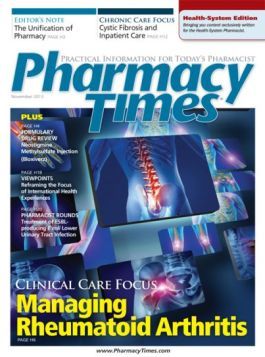Publication
Article
Pharmacy Practice in Focus: Health Systems
Neostigmine Methylsulfate Injection (Bloxiverz)
Author(s):
Bloxiverz, manufactured by Éclat Pharmaceuticals, is the first and only FDA-approved neostigmine methylsulfate injection.
Bloxiverz, manufactured by Éclat Pharmaceuticals, is the first and only FDA-approved neostigmine methylsulfate injection. Bloxiverz is indicated for postoperative reversal of effects produced by nondepolarizing neuromuscular blocking agents (NMBAs) administered for surgical procedures.1 Because neostigmine was first introduced in 1931, its use precedes the 1938 Food, Drug, and Cosmetic Act, which requires premarket approval of all drugs to assure patients and consumers of drug safety and efficacy; therefore, neostigmine has remained on the market as an unapproved, grandfathered drug until the recent introduction of Bloxiverz.2
Pharmacology/Pharmacokinetics
Bloxiverz, a cholinesterase inhibitor, indirectly increases acetylcholine levels in the synaptic cleft by competitively binding to cholinesterases, thus blocking acetylcholine degradation. Acetylcholine, in turn, can then compete with nondepolarizing neuromuscular blocking agents for the same binding site on muscarinic and nicotinic receptors and, hence, reverse neuromuscular blockade after surgery. However, since neostigmine does not readily cross the blood-brain barrier, Bloxiverz does not significantly affect central nervous system cholinergic function.1
Bloxiverz onset of action occurs within 1 to 20 minutes, with a duration of action of 1 to 2 hours, and an elimination half-life of 24 to 113 minutes. The volume of distribution ranges between 0.12 and 1.4 L/kg with 15% to 25% protein binding (human serum albumin). Neostigmine undergoes hepatic metabolism with 50% of the drug excreted unchanged in the urine. Total neostigmine clearance is estimated to be between 1.14 and 16.7 mL/kg/min.1,3
Dosing and Administration
Bloxiverz should be administered as an intravenous (IV) injection over at least 1 minute. To achieve a train-of-four (TOF) twitch ratio of 90% (TOF0.9) within 10 to 20 minutes of administration, a 0.03 to 0.07 mg/kg dose is recommended, and peripheral nerve stimulation devices capable of delivering a TOF stimulus are crucial for treatment initiation as well as for determining possible need for additional Bloxiverz doses. Dosing is highly individualized and is determined based on the half-life of the NMBA being reversed, the extent of recovery that has already occurred prior to administration, and whether there is a need to rapidly reverse the NMBA effects.
The 0.03 mg/kg dose is recommended for reversal of NMBAs with shorter half-lives (eg, rocuronium) and when the first twitch response to TOF stimulus is much greater than 10% of baseline or when a second twitch is present. The 0.07 mg/kg dose is recommended for NMBAs with longer half-lives (eg, vecuronium, pancuronium), when the first twitch response is relatively weak (not substantially greater than 10% of baseline), or if there is need for a more rapid recovery of the neuromuscular blockade. The recommended maximum total dose is 0.07 mg/kg or 5 mg, whichever value is less.1 These dosing guidelines apply for adult and pediatric patients.
Clinical Efficacy
Used in practice for over 70 years, the efficacy of neostigmine has been well established; thus, there have not been any studies conducted specifically on the use of Bloxiverz.1 One study utilized a randomized controlled trial to assess neostigmine’s effectiveness, using various low doses, in antagonizing a shallow atracurium block compared with no neostigmine use, with normal saline (NS) as control. Investigators designated the time interval between the intervention (various neostigmine doses as well as NS) and a TOF ratio greater than 0.9 as a primary efficacy end point and neuromuscular recovery after 5 and 10 minutes as a secondary efficacy end point. With these end points in mind, the study demonstrated that, compared with no neostigmine, the time to a TOF ratio greater than 0.9 was shortened and neuromuscular recovery at 5 and 10 minutes was more profound when a neostigmine dose of 10 mcg/kg was administered.4
Medication Safety
Because Bloxiverz can cause bradycardia, an anticholinergic agent, particularly atropine sulfate or glycopyrrolate, should be administered intravenously prior to Bloxiverz using a separate syringe. In addition to bradycardia, the most common adverse reactions during treatment include nausea, vomiting, and dry mouth.1
Availability and Cost
With a current shortage of neostigmine injection products the recent approval of Bloxiverz has been timely.5 It is supplied as 0.5-mg/mL and 1-mg/mL solutions, and both strengths are available as 10-mL multiple-dose vials in packages of 10. Vials should be stored at room temperature and protected from light.1 The average wholesale price (AWP) of each vial, irrespective of strength, is $15.6 For more information, go to www.bloxiverz.com.
Ashley N. Lewis, PharmD, BCPS, is a drug information specialist at University of North Carolina (UNC) Hospitals and a clinical assistant professor at the UNC Eshelman School of Pharmacy.Sandra Hanna, PharmD Candidate, is a second-year pharmacy student at the UNC Eshelman School of Pharmacy and an intern at the UNC Hospital Drug Information Center in Chapel Hill, North Carolina.
References
- Bloxiverz [package insert]. Chesterfield, MO: Éclat Pharmaceuticals; May 2013.
- Unapproved drugs: drugs marketed in the United States that do not have required FDA approval. FDA website. www.fda.gov/Drugs/GuidanceComplianceRegulatoryInformation/EnforcementActivitiesbyFDA/SelectedEnforcementActionsonUnapprovedDrugs/. Published August 22, 2012. Accessed September 13, 2013.
- Neostigmine: drug facts and comparisons. Facts & Comparisons [online database]. St. Louis, MO: Wolters Kluwer Health, Inc; July 2013. Accessed October 7, 2013.
- Fuchs-Buder T, Baumann C, De Guis, J, et al. Low-dose neostigmine to antagonize shallow atracurium neuromuscular block during inhalation anaesthesia: a randomized controlled trial. Eur J Anaesthesiol. 2013; 30:594-598.
- Neostigmine methylsulfate injection drug shortage. American Society of Health-System Pharmacists website. www.ashp.org/DrugShortages/Current/Bulletin.aspx?id=311.Published August 16, 2013. Accessed September 13, 2013.
- Phone conversation with drug representative from Éclat Pharmaceuticals, Chesterfield, MO. September 13, 2013.







